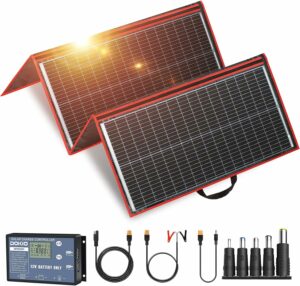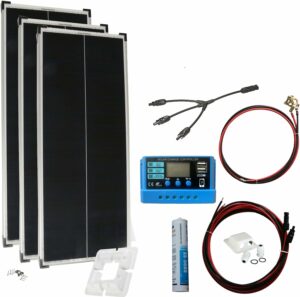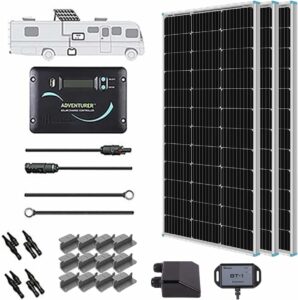How Much Power Does A 300-Watt Solar Panel Produce
Introduction
In an age when environmental concerns and sustainability are at the forefront of our collective consciousness, the quest for cleaner and more efficient energy sources has never been more significant.
Solar power, with its promise of harnessing the sun’s abundant energy, has taken center stage in this movement towards a greener future.
Provo Green Products embodies a beacon of trust in sustainable discoveries, offering choices that enhance your life and leave a positive mark on our planet.
Leveraging extensive expertise in manufacturing, construction, and various trades, we provide a solid foundation for sustainable living.
Our meticulous research process guarantees that our information about each product is precise and current, allowing you to make informed decisions.
Whether your interest lies in solar products, electric bikes, or other eco-friendly alternatives, our commitment to credibility ensures you have access to dependable insights, guiding your journey toward a more sustainable lifestyle.
Provo Green Products is your go-to destination for finding the right green products for your lifestyle.
Disclosure: As an Amazon Associate, we may earn from qualifying purchases. This does not affect the product pricing whatsoever.
Factors Affecting Solar Panel Efficiency
Solar panel efficiency is a crucial aspect to consider when evaluating how much power a 300-watt solar panel can produce.
To fully grasp the complexities of this topic, it’s essential to delve deeper into the various factors that influence the efficiency of solar panels:
- Sunlight Intensity and Duration:
- Solar panels depend on sunlight to generate electricity. The intensity and duration of sunlight play a pivotal role in their efficiency. Panels perform best in direct, unobstructed sunlight, but they can still produce power on cloudy days or in lower light conditions.
- Angle and Positioning of Solar Panels:
- The angle at which a solar panel is installed and its orientation relative to the sun are critical factors. Panels should ideally face south in the Northern Hemisphere and north in the Southern Hemisphere to capture the most sunlight. Additionally, adjusting the tilt angle according to your location’s latitude can optimize energy generation.
- Climate and Geographical Location:
- The climate and geographical location of your solar panel installation can significantly impact its efficiency. Regions with more sunlight throughout the year tend to have higher solar panel efficiency. On the other hand, areas with frequent cloud cover or long winters may experience reduced efficiency.
- Temperature:
- Solar panels are sensitive to temperature. High temperatures can reduce efficiency. While some heat is necessary for the operation of solar panels, excessive heat can cause a decrease in output. Proper ventilation and maintaining an optimal operating temperature are essential for maintaining efficiency.
- Shading and Obstructions:
- Any shading on solar panels, whether from nearby trees, buildings, or other obstructions, can substantially reduce their efficiency. Even a small amount of shading can lead to a considerable drop in power production. It’s essential to ensure that your solar panels remain unshaded throughout the day.
- Quality and Age of Solar Panels:
- The quality and age of the solar panels themselves are also critical factors. High-quality panels tend to be more efficient and have a longer lifespan. Over time, solar panels may degrade, resulting in reduced efficiency. Regular maintenance and monitoring are essential to maximize their performance.
- Panel Orientation and Tracking Systems:
- Some advanced solar installations incorporate tracking systems that follow the sun’s path throughout the day. This dynamic orientation can significantly boost efficiency by ensuring the panels face the sun directly.
- Dust and Debris:
- Dust, dirt, and debris can accumulate on the surface of solar panels over time, reducing their efficiency. Regular cleaning is necessary to maintain optimal performance.
By taking these factors into account and addressing them effectively, you can optimize the efficiency of your solar panels.
This optimization is key to maximizing the power production of a 300-watt solar panel and achieving the expected results from your solar energy system.

Calculating Expected Power Output
Understanding how to calculate the expected power output of a 300-watt solar panel is vital when planning a solar energy system.
The actual power output can vary based on several factors, and it’s essential to consider these variables to get a realistic estimate:
- Wattage and Capacity Calculations:
- A 300-watt solar panel is designed to produce 300 watts of power under specific conditions, typically called Standard Test Conditions (STC). These conditions include a panel temperature of 25°C (77°F), one kilowatt per square meter (1000 W/m²) of sunlight intensity, and direct sunlight. Therefore, under ideal circumstances, you can expect a 300-watt panel to produce 300 watts per hour.
- Real-World Performance vs. Theoretical Output:
- In practice, solar panels rarely operate under ideal conditions all the time. Real-world performance can be influenced by various factors such as temperature, shading, and the panel’s orientation. As a result, the actual power output may differ from the theoretical 300 watts.
- Calculations in Different Conditions:
- It’s essential to understand how solar panel output varies in different conditions. For instance, power output may be significantly lower on overcast days or during winter when days are shorter and the sun is lower in the sky. Calculations should consider these variables.
- Hourly and Daily Production:
- To estimate the daily power output of a 300-watt solar panel, consider the number of sunlight hours in your location. This information can typically be found in solar insolation maps or databases. The formula is simple: daily power output (in watt-hours) = panel wattage (in watts) x daily sunlight hours.
- Case Studies and Examples:
- Providing real-world case studies and examples can offer valuable insights. Sharing data from actual installations with 300-watt panels in various locations and conditions can help readers understand what to expect in practice.
- Monitoring and Adjustments:
- Solar panel systems often come with monitoring tools that allow you to track their performance. Regularly monitoring the output and making necessary adjustments, such as cleaning the panels or addressing shading issues, can help maintain or improve efficiency.
- Expected Return on Investment (ROI):
- Understanding the expected power output is crucial when evaluating the economic feasibility of a solar panel system. By knowing the anticipated energy production, you can calculate potential energy savings and the ROI of your investment.
In summary, calculating the expected power output of a 300-watt solar panel involves more than just its nameplate capacity. It requires a comprehensive consideration of the factors affecting efficiency in real-world conditions.
By understanding and accounting for these variables, you can make more accurate projections and maximize the benefits of your solar energy system.

Implications for Energy Needs
Understanding the implications of a 300-watt solar panel’s power output for your energy needs is essential.
This section will explore how much power a 300-watt solar panel can provide and the broader significance for residential and commercial energy applications:
- How Much Power Can a 300-Watt Solar Panel Provide?
- To put it simply, a 300-watt solar panel can generate up to 300 watts of electricity under ideal conditions. Understanding this baseline capacity is a starting point for assessing its contribution to energy needs.
- Residential Applications:
- For residential use, a 300-watt solar panel can be a valuable addition to your energy supply. Consider the typical energy consumption of your household. A 300-watt panel alone may not cover all your energy needs, but it can significantly offset your electricity bills. Multiple panels can be installed to meet a more significant portion of your energy consumption.
- Commercial Applications:
- In commercial settings, such as businesses or industrial facilities, the implications are even more significant. Large-scale solar installations with multiple 300-watt panels can yield substantial energy savings and reduced operational costs. Companies that adopt solar energy often experience a positive impact on their bottom line.
- Energy Savings:
- The use of 300-watt solar panels contributes to substantial energy savings over time. The savings depend on the number of panels installed, energy consumption, and local utility rates. It’s essential to calculate potential savings based on your specific situation.
- Environmental Impact:
- Transitioning to solar power, even on a small scale with 300-watt panels, has a positive environmental impact. It reduces reliance on fossil fuels, decreases greenhouse gas emissions, and supports sustainability efforts. This aligns with a global commitment to combat climate change.
- Hybrid Systems and Energy Storage:
- Combining 300-watt solar panels with energy storage solutions, like batteries, can enhance their effectiveness. Excess energy generated during the day can be stored for use during the night or on cloudy days, increasing self-sufficiency and reducing dependence on the grid.
- Local Regulations and Incentives:
- Depending on your location, there may be regulations and incentives that encourage the adoption of solar energy. Understanding these can have a significant impact on your energy needs and the overall cost-effectiveness of solar panel installations.
- Long-Term Considerations:
- Solar panels are a long-term investment. While they require an initial capital outlay, they often pay for themselves over time through energy savings. It’s crucial to consider the long-term implications and benefits when evaluating their role in your energy strategy.
A 300-watt solar panel can have far-reaching implications for residential and commercial energy needs. It offers the potential to reduce energy costs, support environmental sustainability, and provide a degree of energy independence.
Assessing your specific energy requirements and considering the broader impacts of solar power is critical to making informed decisions about integrating these panels into your energy portfolio.
Choosing the Right Solar Panel
Selecting the most suitable solar panel for your needs is a critical decision in your solar energy journey.
This section will provide a detailed exploration of the key factors to consider when choosing a solar panel:
- Types of Solar Panels:
- There are various types of solar panels available, such as monocrystalline, polycrystalline, and thin-film. Understanding the differences in efficiency, aesthetics, and cost can help you make an informed choice.
- Panel Efficiency:
- Efficiency is a crucial factor. Higher-efficiency panels generate more power from the same surface area. Assess the trade-offs between panel efficiency and your budget, as more efficient panels are often more expensive.
- Wattage and Capacity:
- The wattage of a solar panel, such as the 300-watt panel in question, determines its power output. Evaluate your energy needs and available space to determine how many panels of what capacity are required for your project.
- Quality and Durability:
- Quality is paramount. High-quality panels are more durable and reliable. They often come with more extended warranties and can withstand various weather conditions. It’s essential to invest in panels that will last for many years.
- Cost Considerations:
- Assess your budget and the cost of the solar panels. While higher efficiency panels tend to be more expensive, consider the long-term return on investment in terms of energy savings.
- Aesthetics and Design:
- The appearance of solar panels may matter, especially in residential installations. Some panels are designed to be less conspicuous and more aesthetically pleasing. Evaluate the options available to align with your preferences.
- Local Regulations and Incentives:
- Be aware of local regulations and incentives that may affect your choice. Some regions have specific requirements for solar panel installations, and there might be financial incentives, tax credits, or rebates available.
- Installation and Maintenance:
- Consider the ease of installation and the maintenance requirements of the panels. Some types may require more maintenance, and professional installation might be necessary.
- Compatibility with Inverters and Batteries:
- If you plan to incorporate an inverter or battery storage system, ensure the chosen solar panels are compatible with these components. This compatibility can affect the overall efficiency and performance of your solar system.
- Future Trends in Solar Panel Technology:
- Stay informed about the latest advancements in solar panel technology. Emerging innovations, such as bifacial panels or improvements in energy conversion efficiency, may influence your decision.
- Manufacturer Reputation:
- Research the reputation and track record of the solar panel manufacturer. Established and reputable manufacturers tend to produce more reliable products.
- Warranty and Support:
- Examine the warranty offered with the panels and the availability of customer support. A robust warranty and reliable customer service can provide peace of mind.
Choosing the right solar panel involves comprehensively evaluating various factors, including efficiency, cost, quality, aesthetics, and compatibility.
Your decision should align with your energy needs, budget, and long-term goals.
Staying informed about the latest industry developments and local incentives is also essential in making a well-informed choice for your solar panel installation.

Conclusion
Making an informed choice when selecting the right solar panel is crucial for achieving your energy goals.
Whether you’re looking to reduce your electricity bills, lessen your environmental impact, or invest in a sustainable future, understanding the complexities of solar panel technology empowers you to make decisions that align with your objectives.
As solar energy continues to evolve and expand, these panels serve as a shining example of the possibilities in our journey toward cleaner, greener energy solutions.
Stay in Touch!
I’am a dedicated entrepreneur with many years of experience and an integrity-driven individual who is highly motivated to succeed. Leveraging extensive expertise in manufacturing, construction, and various trades, we can provide a solid foundation for sustainable living. Our meticulous research process guarantees that our information about each product is precise and current, allowing you to make informed decisions. A deep understanding of business operations empowers me to consistently implement improvements that result in ongoing success. Visit site.
